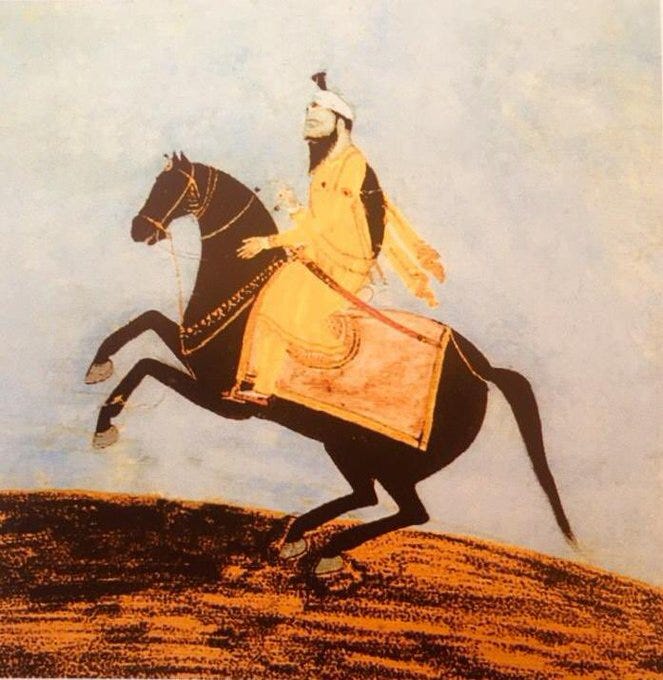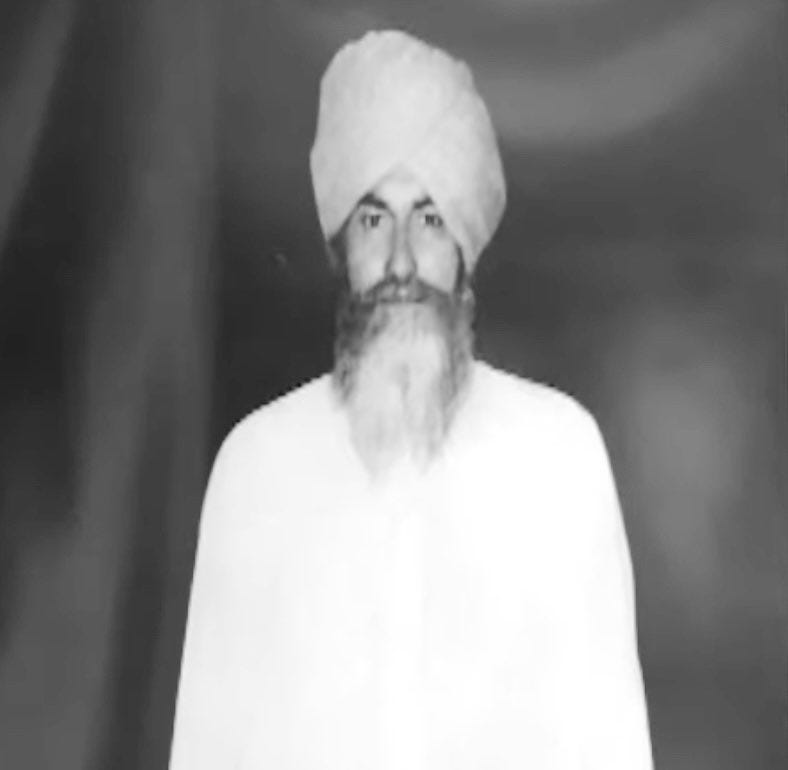The House of Badal
Tracing the little known advent of the influential Badal family on the political map of Punjabi history.
Throughout the history of civilisations, the migration of tribes has been a constant. The Dorian and Ionian influx spearheaded the formation of the Hellenic éthnos. Similarly, the Lombards who established themselves across the Italian peninsula, the Kalmyks who settled in Kalmykia (Southern Russia) and the Magyars who inhabited modern Hungary were all instrumental in transforming the territories they adopted from lacklustre backwaters into formidable regional states. Their resettlements often brought preexisting tribal aristocracies to rule over their new abodes as kings, lords or feudal subordinates.
This was likewise the case for Punjab, which saw intense resettlements of the Jatt tribes from Sindh and Rajasthan throughout the 11th and 15th centuries CE. The communities underwent a drastic transformation, having to discard the pastoralism their forefathers held dear in favor of a settled life as agriculturalists in the fertile plains of Pentapotamia. This evolution was not smooth but took quite some time, evidenced by accounts of so-called Djat tribal highwaymen who looted traders, travelers and soldiers alike throughout the Lodi and early Mughal rule. Sidi Ali Reis, a Turkish naval commander and traveler, encountered large numbers of Jatts harassing him during his journey from Sindh to Lahore in 1555:
As the route past Kandahar was made unsafe by the inroads of Sultan Bahadur --- the Sultan [Mahmud, ruler of Sind] offered to give me an escort by the way of Lahore, warning me to be on my guard against Djats, a hostile tribe which had its abode there.
He also provided me with a letter of recommendation to Humayun, and an escort of 250 mounted cameldrivers from Sind. Thus we departed about the middle of Shaaban and reached the fortress of Mav (Mau) in five days, travelling by the way of Sultanpoor. As the Djats were very troublesome, we did not take the route of Djenghelistan (the forest), but preferred to go through the steppe. On the second day we came to the spring but found no water, and many of my companions nearly succumbed with heat and thirst. I gave them some Teriak (opium), of the very best quality, and on the second day they recovered. After this experience we deemed it advisable to leave the desert and to return to Mav.
Our escort from Sind was afraid of the wood, and I had to inspire my own people with fresh courage -- trusting in God's protection. Thus, after manifold dangers, we came after ten days to Utchi or Autchi (Vchh). In the beginning of Ramazan we resumed our journey and came to river Kara ar Kera (Ghara), which we crossed by means of raft. The people of Sind gave us permission to proceed as far as the Matchvara (Machhiwara) and this river crossed on boats. On the other we found 500 Djats awaiting us, but our firearms frightened them and they did not attack. We advanced unmolested & reached the town of Multan.
What becomes clear from this voluminous quote is that by the mid-16th century, Punjab was commonly assumed to be the “abode” of the Jatts, and they were very hostile to outsiders—especially invaders and foreigners.
However, the next few decades would bring Emperor Akbar onto the Mughal throne, and his conciliatory approach would pacify the heads of various Jatt tribes into accepting Zamindari status:1
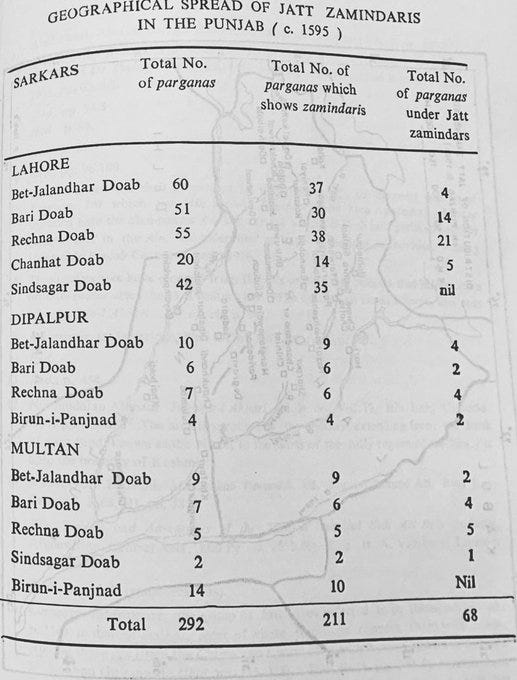
— — -
ਢਿੱਲੋਂ ਸਨ ਵੱਡੇ ਦਾਤਾਰਾ।
The Dhillons are great donors.
- Vaar Jattan Chaudharian Ki, Sidh Jiauna, 18th century.
In the late 17th century, an elder named Baba Ghudda decided to leave his village of Sur Singh, near the vicinity of Sri Ramdaspur. With him came the close family of his biradari, the clan of Dhillons. They wandered around Punjab until eventually settling near Bathinda,2 where Baba Ghudda founded a new village which came to be known by his name, Ghudda. The area was part of the dense Djenghelistan that Sidi Ali Rais had mentioned in his treatise.
At the time, Dhillons were not yet native to this part of Malwa. However, with the passage of time they became well entrenched in the local Jatt kinship networks. It is possible that they brought the Nanakpanth, as the Sikh faith was then-known, to their new homelands. The Dhillons settled across the plains surrounding the city of Bathinda.
Come the time of the Khalsa, a great mass of Jatt tribesmen and mercenaries had joined the veterans of Guru Gobind Singh at the Lakhi Jangal, a forest that covered the vicinity of Ghudda. An ode to the Khalsa that had been garrisoned for the Guru at Lakhi Jangal has been attributed to Guru Gobind Singh himself, and is part of the apocryphal compositions of the Sri Dasam Granth Sahib.3 Alongside the warlike tribe of Brars, headed then by the great chief Chaudhari Kapura, local Sikhs took part in the Battle of Muktsar, a skirmish which resulted in the establishment of Sri Muktsar Sahib.
During the rise of Sikh rule over the Punjab with the formal independence of the Misls, Kirpal Singh Dhillon from Ghudda distinguished himself in battles with the Rajas of Patiala and Ladwa. In 1770, Sardar Sahib Singh of Ladwa was betrothed and married to Kirpal Singh’s sister, and in return Kirpal Singh received the fief of Shamgarh, a town in Karnal. His descendants, the Shamgarh Sardars as they came to be known, would also form family ties with the royal family of Jind.4
The 1857 Sepoy Mutiny was an important event for Malwa. While the Sardars and Safedphoshes5 of the Sikh kingdoms swore fealty to the Company, local peasants ventured south to take part in the looting that followed the May 1857 conquest of Delhi by the rebels. Following the British recapture of Delhi in September, two brothers from Ghudda were hanged for their involvement in the mutineer rapine.
According to veteran journalist Bakhtaur Singh Dhillon,6 this event left his ancestor, a child of 11, forever orphaned. His sister, Partap Kaur, resolved to never marry and to provide for the young boy for the rest of her life. She adopted masculine garb and tied a turban on her head, declaring to the villagers of Ghudda that she be henceforth known as Partap Singh.
The young child she was looking after began to be courted by the extended family in the village. One Fateh Singh (not the son of Kirpal Singh pictured above, but another of the same name within the Dhillon biradari), an avowed gambler and distant uncle, called the teenage boy for bets on games of cards. The naive adolescent nodded in assent, only to be constantly defeated.
The first bet Fateh Singh won was on the boy’s family livestock.
The news reached Partap Singh through a well-wisher, who declared to her that Fateh Singh would next take over their farmlands, having just won a bet on their cattle. Hearing this, she was moved to action and immediately went over to the place the game was being played and struck Fateh Singh on the head with a staff.
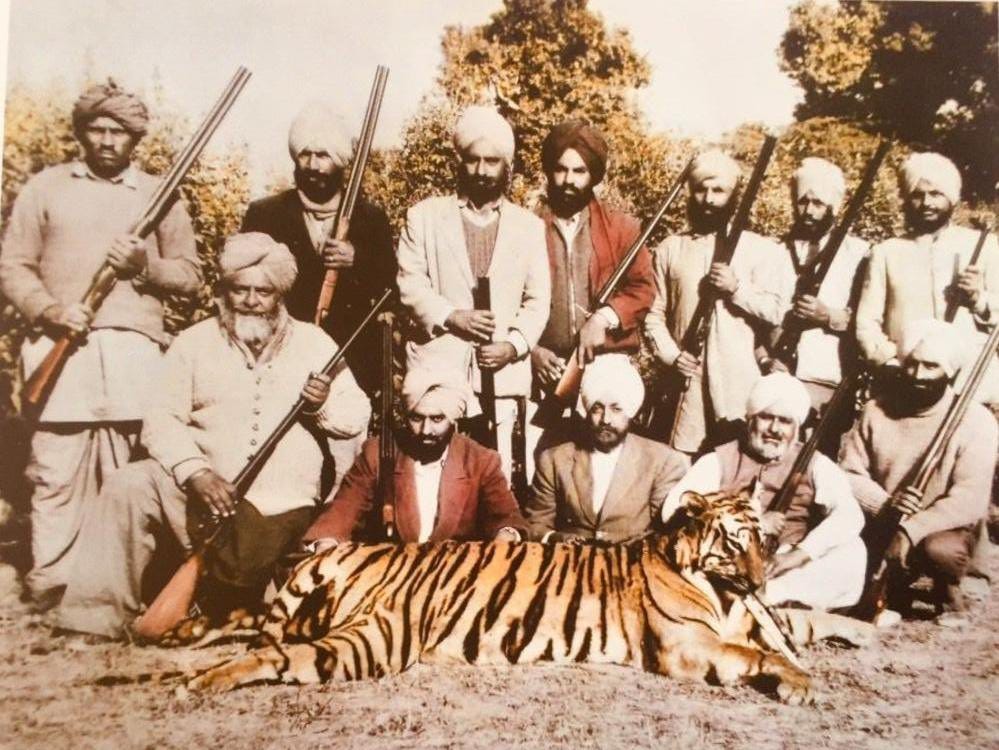
This flared-up hostility led to the call of a panchayat convention among the elders of the Dhillon biradari. The schism was so severe that the Shamgarh Sardar, Kirpal Singh himself, personally traveled from his distant estates to resolve the dispute in his ancestral village. In keeping with the general principles that governed such disputes, it was decided that Fateh Singh’s family, being an older line, would move to the village of Badal, while Partap Singh and her protégée would remain in Ghudda. This was followed by members of each family of every caste in Ghudda migrating to Badal to help in its repopulation.7
— — -
Badal was a village founded in the 18th century by a Dogar Muslim named Badal Khan. Its ‘air and water’ did not prove to be to his liking, and so it was gradually abandoned, though the 1888-89 Gazetteer of the Ferozpore District records it as inhabited by a Dogar majority.8
With the aid of Sardar Kirpal Singh, Fateh Singh and his son Ranjit Singh were able to acquire considerable landholdings, thus increasing their social status. It was agreed that the farmlands in both Ghudda and Badal would be equally split among the Dhillon biradari.
As the 20th century dawned and Sikhs began to develop a more pronounced political consciousness, Ranjit Singh would keep a rather neutral stance during the Gurdwara Reform Movement. But his two sons, Raghuraj Singh and Gurraj Singh, would go on to be more active in Sikh politics than their father.
On the 14th of August, 1943, multiple shareholders filed for the first bus transport company in West Malwa, christened “Dabwali Transport Company Ltd.”9 Owing to a dispute, the company was partitioned and came under the ownership of the Dhillons of Badal.
The company acquired a modest fleet of steam-powered bus vehicles to transport passengers and cargo on the dirt roads stretching from the market of Bathinda to the countryside. At first, the company was like a family business—an old passenger recalled Gurraj Singh would drive the bus while the two sons of his brother Raghuraj Singh, Paash (Parkash Singh) and Daas (Gurdas Singh), would be its conductors that dealt with the constant complaints and queries from passengers. With such work, the family became quite prosperous. Their success was very apparent to the famed Babu Rajab Ali, who in his early 20th century kavishri notes that:
ਬੀਦੋ ਵਾਲੀ, ਬਾਦਲ ਨੱਗਰ ਖ਼ਾਨਦਾਨਾਂ ਦੇ।
Bidowali and Badal are towns of magnificent lineages.10
The family began aligning with the industrialists of the pro-Independence Sikh middle class, despite their presence amongst the common peasantry of the countryside and their familial relations with the landed gentry of the Sikh states, groups that were slower to take up the Independence cause. Gurraj Singh would join the Shiromani Akali Dal and be involved in various agitations, later becoming elected to serve in the Indian Rajya Sabha from 3 April 1952 to 2 April 1956.11 Raghuraj Singh would centre his attention towards managing the agricultural holdings while providing his sons and nephews with the best possible education.

Parkash Singh would later recall how his formative education began in the nearby village of Lambi which he would reach atop a camel, a testament to the geography and fauna of pre-Green Revolution Malwa. He would go on to study in Sikh National College and graduate from Foreman Christian College, both at Lahore. Although an average student, a classmate of his would later recall,12
“Badal and his friends from the Malwa region stayed together and we used to call them Firozepurias…[they] used to get endless supplies of cans of desi ghee from their villages and they were all very strong.”
In the years leading up to the partition of India, the Sikhs were represented in part by Sardar Baldev Singh, a Jatt from Dumna in Ropar, whose entrepreneurial father Inder Singh had bequeathed him a vast fortune and a solid foothold in the steel industry. According to Sirdar Kapur Singh’s Sachi Sakhi, Baldev Singh controlled the daily finances of Giani Kartar Singh, President and main leader of the Shiromani Akali Dal in the 1940s.13 Making common cause with families of similar status, Baldev Singh married his son Surjit Singh to a girl from the extended family of the Badals.
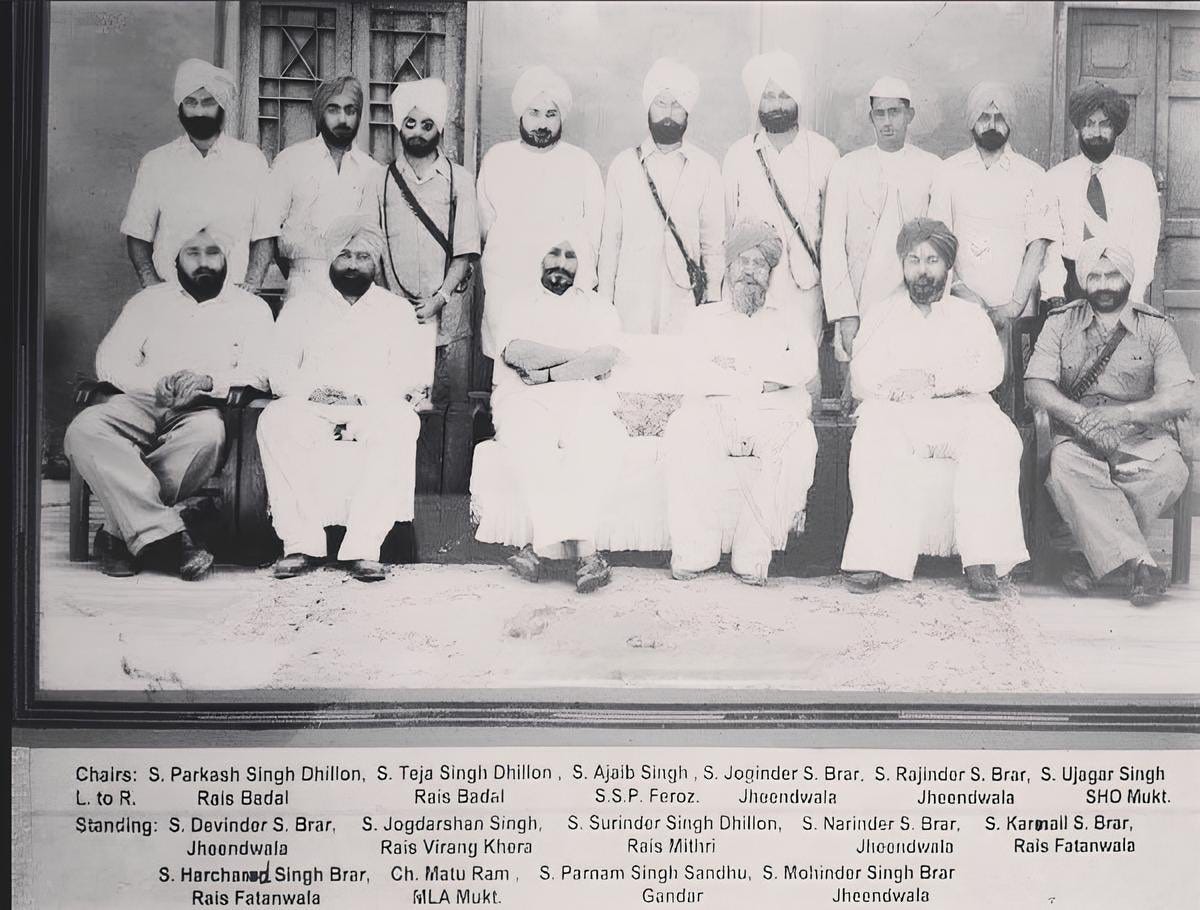
In 1949, Parkash Singh had a request for his uncle and mentor Teja Singh Badal (who was also an in-law of Baldev Singh and later Health Minister of Punjab). It was to ask Giani Kartar Singh,14 then-Revenue Minister of Punjab, to appoint him as a Naib Tehsildar. Upon this supplication of his uncle, both Giani Kartar Singh as well as then-Defence Minister Baldev Singh retorted that the young Parkash Singh was more than suited to run for elections instead, as a representative of the Sardars.
Kartar Singh realised he had met an extraordinary youngster, with all the makings of a brilliant politician. “Why do you want to be a naib tehsildar?” he asked. “Join our party. One day you’ll appoint them.”
Parkash Singh would then join the Shiromani Akali Dal as an ordinary member and contest his first legislative assembly elections in 1957.15 Wading carefully through the Sant Fateh Singh and Master Tara Singh split within the Akali Dal, in the span of 13 years, he rose to the position of Chief Minister of Punjab in 1970—a feat he would repeat four more times within his life.
A country gentleman…a big farmer by profession, quite rich by profession, well educated and modern in outlook, with a charming and gifted wife.
- "My days as Governor", DC Pavate, Governor of Punjab from 1967 till 1973, referring to Parkash Singh Badal.
Continuantur.
— — -
A note on medieval Jatt immigration in the Punjab, Iftikhar Ahmad Khan, Proceedings of the Indian History Congress Vol. 43 (1982), p.342-350.
https://artsandculture.google.com/entity/ghudda/g11b81xmk10?hl=en
Lakhi Jungle
Lakhi Jungle was a jungle found on the outskirts of the Punjab region, found west of Bathinda, encompassing modern-day Ferozepur, Dipalpur, Bahawalpur and Pakpattan. Later on, the jungle would be used by Sikhs to seek refuge from the Mughals and Durranis, enabling them to use guerrilla tactics to ambush the enemy. During the British era, the jungle was…
Chiefs And Families Of Note In The Punjab, Lahore 1909, p.43-44.
Lit. “a man dressed in clean clothes, one in a white dress”, euphemism for rural notaries and noblemen.
The total population of the village in 1889 was 2,655, 1888-89 Gazetteer of the Ferozpore District, p.82.
Ibid.
https://www.punjabi-kavita.com/PoetryBabuRajabAli.php#Kavishri13
https://cms.rajyasabha.nic.in/UploadedFiles/ElectronicPublications/who_1952.pdf
https://www.tribuneindia.com/news/punjab/parkash-singh-badal-was-tall-handsome-and-came-from-a-wealthy-zamindar-family-classmate-in-lahore-recalls-their-hostel-days-501481
A generous monthly allowance of 500 rupees was regularly offered to Giani Kartar Singh by Baldev Singh, a handsome sum when adjusted for inflation. Sachi Sakhi, Sirdar Kapur Singh, 1972.
Giani Kartar Singh: “The Brain of the Sikhs”
“I am confident that the whole Panth will back the idea of Azad Punjab and the brave sons of Guru Gobind Singh shall finally have a homeland of their own.” - Giani Kartar Singh, Azad Punjab, page 57, published in 1944. Giani Kartar Singh was born on the 22nd of February, 1902 to father Risaldar Bhagat Singh and Jeevan Kaur at Chak 40 in Lyallpur. Chak 40…
https://www.hindustantimes.com/india/the-badals-of-punjab/story-ktR9YrIzJUhKTOsi7BSczK_amp.html


